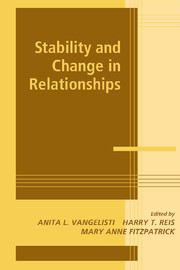Book contents
- Frontmatter
- Contents
- Contributors
- Preface
- PART ONE ACTORS: THE SCAFFOLDING OF STABILITY AND CHANGE
- PART TWO BEHAVIORS: THE PROCESSES OF STABILITY AND CHANGE
- 5 Serial Arguing over the Relational Life Course: Antecedents and Consequences
- 6 Communication, Relationship Concerns, and Satisfaction in Early Marriage
- 7 Sacrifice in Romantic Relationships: An Exploration of Relevant Research and Theory
- 8 Stability and Change in Social Relations: Perspectives from Gerontology and Stress Research
- 9 What Microanalysis of Behavior in Social Situations Can Reveal about Relationships across the Life Span
- 10 Developing a Multifaceted View of Change in Relationships
- PART THREE CONTEXTS: SOCIAL ENVIRONMENTS FOR STABILITY AND CHANGE
- Author Index
- Subject Index
10 - Developing a Multifaceted View of Change in Relationships
Published online by Cambridge University Press: 21 October 2009
- Frontmatter
- Contents
- Contributors
- Preface
- PART ONE ACTORS: THE SCAFFOLDING OF STABILITY AND CHANGE
- PART TWO BEHAVIORS: THE PROCESSES OF STABILITY AND CHANGE
- 5 Serial Arguing over the Relational Life Course: Antecedents and Consequences
- 6 Communication, Relationship Concerns, and Satisfaction in Early Marriage
- 7 Sacrifice in Romantic Relationships: An Exploration of Relevant Research and Theory
- 8 Stability and Change in Social Relations: Perspectives from Gerontology and Stress Research
- 9 What Microanalysis of Behavior in Social Situations Can Reveal about Relationships across the Life Span
- 10 Developing a Multifaceted View of Change in Relationships
- PART THREE CONTEXTS: SOCIAL ENVIRONMENTS FOR STABILITY AND CHANGE
- Author Index
- Subject Index
Summary
The last 30 years have witnessed an explosion of research on marriage and marital dysfunction. Building on seminal cross-sectional studies contrasting happy couples with distressed couples (for reviews see Bradbury & Fincham, 1987, 1989), one central question has begun to guide the course of marital research: How do marriages change? In contrast to the earlier cross-sectional literature, a large proportion of current marital research seeks to explain how couples can begin their marriages with high levels of satisfaction and then, with surprising regularity, grow to become unhappy in a relatively short period of time. Examining the factors associated with shifts in marital satisfaction is a pragmatic and direct approach to address the problem of marital discord and divorce, and this line of research holds great promise. However, in this chapter we adopt the view that looking at deterioration of marital satisfaction over time is only one facet of understanding change. We believe that relationships can undergo shifts in their basic nature without necessarily demonstrating corresponding changes in satisfaction and that relationships can even experience improvements in satisfaction over time. Focusing too exclusively on deterioration of satisfaction over time precludes the study of these processes. In an effort to expand the focus in this domain, we review previous research within a framework that views change in relationships as a multifaceted process. This will allow us to clarify the strengths and limitations of previous work and to highlight a number of new directions for research.
Information
- Type
- Chapter
- Information
- Stability and Change in Relationships , pp. 228 - 254Publisher: Cambridge University PressPrint publication year: 2002
Accessibility standard: Unknown
- 4
- Cited by
